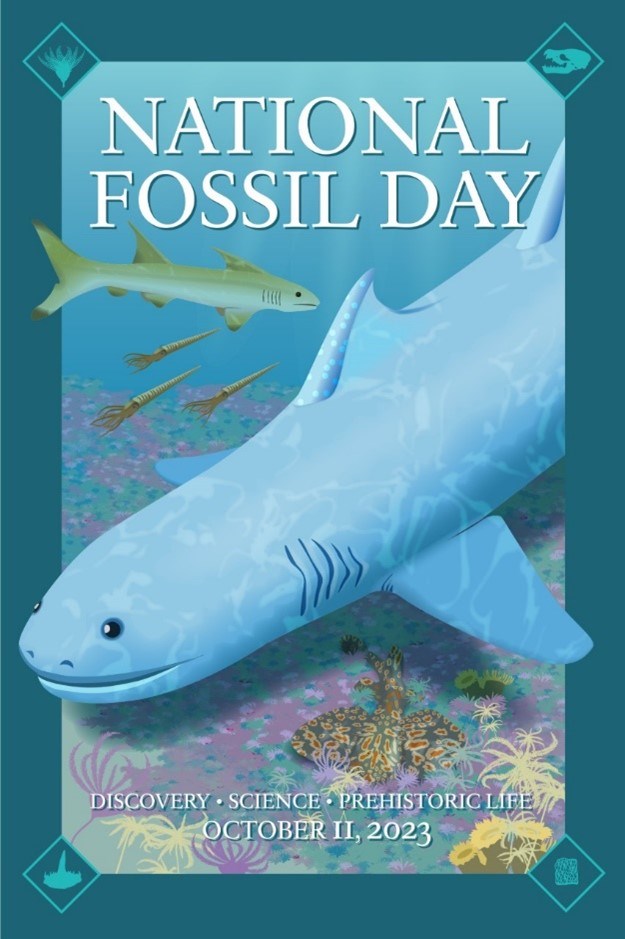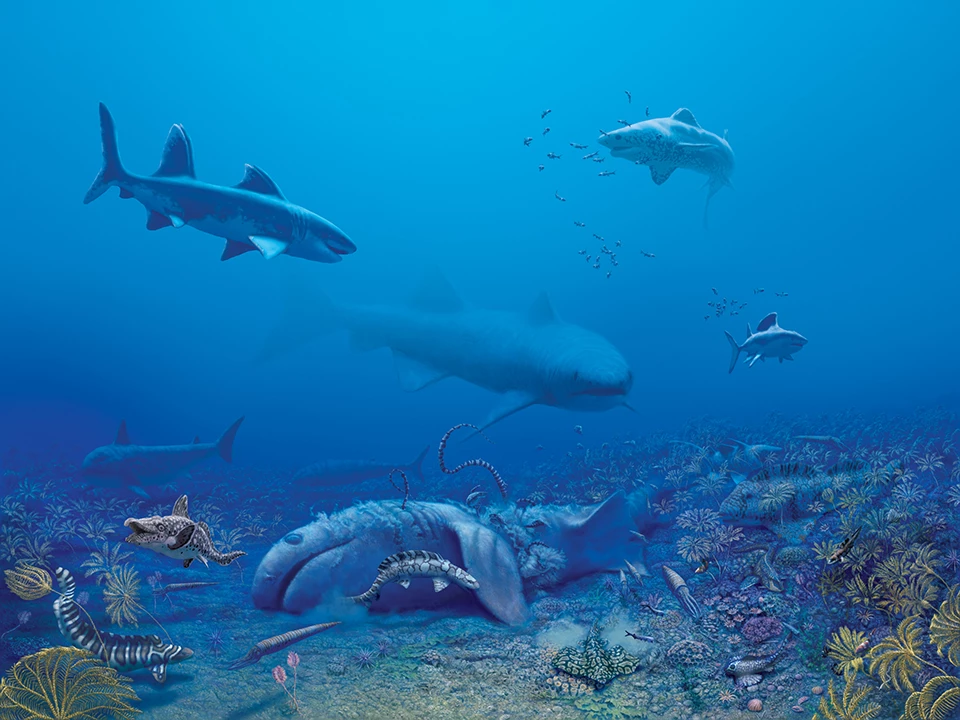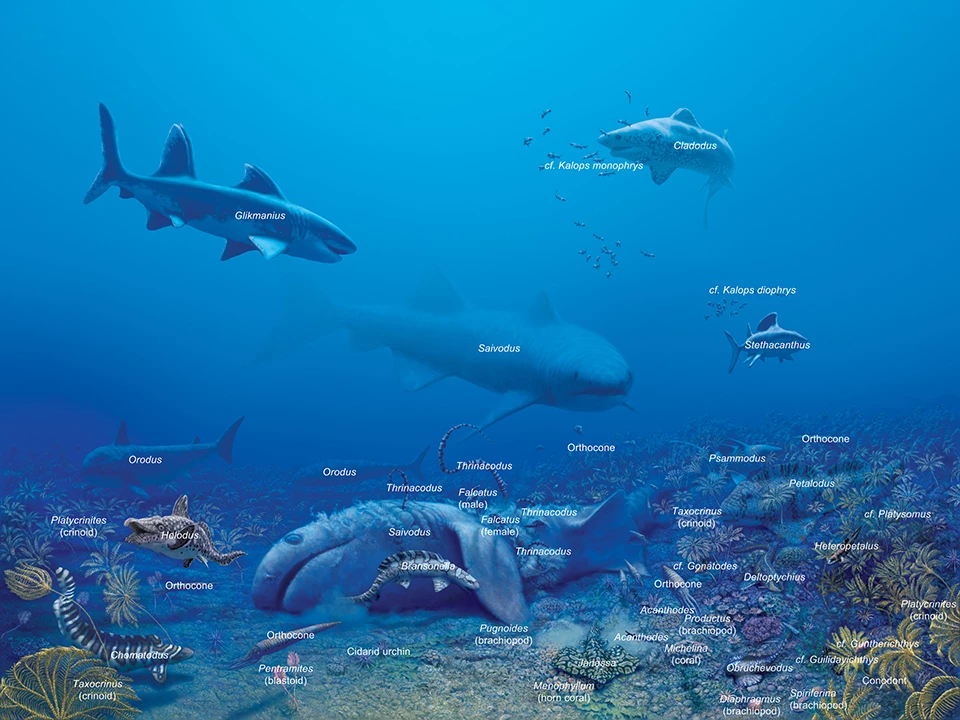Part of a series of articles titled National Fossil Day Logo and Artwork – Prehistoric Life Illustrated.
Article
Fossils of the 2023 National Fossil Day Artwork

Mammoth Cave National Park: A 350-Million-Year-Old Time Capsule in the World’s Longest Cave System
Visitors to Mammoth Cave National Park (MACA) in south central Kentucky are often struck by the immensity of the naturally formed underground passages that make up a cave system which at over 400 miles in length, is the longest cave system in the world. Early cave explorers include prehistoric people from the Late Archaic and Early Woodland period, who used the cave for shelter, exploration and mineral resources. After the rediscovery of Mammoth Cave by settlers in the early 1800s, the cave was used as a saltpeter mine until after the War of 1812. Afterwards, the cave became an early destination in which people from around the country took guided tours by lantern light to marvel at the cave’s never-ending splendor.
Mammoth Cave was designated as a national park on July 1st, 1941 and has welcomed millions of visitors through its dark and mysterious passageways. The park has grown to 52,830 acres (21,380 ha) of lush mixed-deciduous/coniferous forests which includes portions of the most biological diverse riverways in North America, the Green and Nolin Rivers.
The mission of Mammoth Cave National Park is to preserve, protect, interpret, and study the internationally recognized biological and geologic features and processes associated with the longest known cave system in the world, the park’s diverse forested karst landscape, the Green and Nolin rivers, and extensive evidence of human history; and to provide and promote public enjoyment, recreation, and understanding.
The geologic history of Mammoth Cave began approximately 14 million years ago, during the Miocene epoch, when the early Green River began to erode through the sandstone and shale layers protecting the softer limestone beds below. As streams to the southeast across the sinkhole plain dissolved through those softer carbonate rocks forming a series of underground waterways, these would flow to the northeast in the direction of the developing Green River valley and its associated water table. These cave passages cut through limestones and sandstones deposited as far back as 350 million years ago, during the early Carboniferous period when the supercontinent Pangea was nearing completion. As Pangea was forming 350 million years ago, Kentucky was located south of the equator and much of the area at this time was submerged beneath a tropical sea that was connected with other bodies of water as far east as Scotland and Russia. However, as the continents collided to form the supercontinent, these waterways were sealed up, forming new depositional environments.
The cave-forming rocks represent the Mississippian period (359-323 mya) include, from oldest to youngest the St. Louis Formation, Ste. Genevieve Formation, Girkin Formation, and Big Clifty Sandstone. Outside of the Mammoth Cave system, Mammoth Cave National Park also includes rocks representing the very end of the Mississippian period and the beginning of the Pennsylvanian period. The combination of the Mississippian and Pennsylvanian geologic periods is also referred to as the Carboniferous period, so named from the massive coal beds found worldwide dating to these geologic horizons.
Until recently, the most recognized paleontological highlights from Mammoth Cave were somewhat limited to fossils of Pleistocene animals. These fossils include evidence of a wide variety of bats (such as the extinct Stock’s vampire bat), sabertoothed cat, short-face bear, peccary, tapir, and mastodon. Early cave explorers did note the amazingly preserved Mississippian invertebrates which include a diversity of articulated crinoids, blastoids, horn corals, brachiopods, and nautiloid cephalopods. However, it is the recent research into the Mississippian fossil shark record of Mammoth Cave that inspired in the 2023 National Fossil Day artwork. In a short period of time, paleontologists have identified more than 100 species of ancient cartilaginous fishes (from the class Chondrichthyes) from nearly every geologic horizon that forms Mammoth Cave, among them one of the largest sharks to have lived during the Mississippian period as well as a number of new shark species found only at Mammoth Cave National Park!


Left image
Credit: Painting by Julius Csotonyi.
Right image
Credit: Painting by Julius Csotonyi with species labels.
Finding Sharks in the Dark
When people think of field work in paleontology, they tend to picture vast dusty badlands with teams of paleontologists digging for fossils into colorful outcrops of sandstones, mudstones, and shales under a vast open bright sky. At Mammoth Cave, however, explorers traverse narrow passages that stretch miles underground, where natural light does not reach. Some of these passageways at Mammoth Cave still have flowing underground rivers that continue to create new subterranean routes. These kinds of cave environments create new challenges for paleontological research. Cave paleontologists are both cavers and paleontologists, using equipment and techniques reflecting both roles. Tight cave passages, climbs, and descents all limit the field gear that can be brought. Exploring these passages also means that a team could spend much of a day in cave passages and must plan accordingly. Therefore, a cave paleontology field team must balance how much space to give fossil collecting tools, food, water, and caving equipment in small packs, while also wearing cave helmets with head lamps, gloves, and knee pads for safety while traversing cave passageways. Tools tend to be limited to small chisels and rock hammers to gently extract the delicate fossil teeth. Occasionally, a portable lightweight battery-powered circular saw is needed to cut a small block containing a shark fossil.
A large portion of Mammoth Cave can easily be accessed on well-established trails, but to get to the area where known shark fossils occur today means going off-trail into passages that are very narrow or have a low ceiling. For some of these shark fossil sites, a paleontologist must crawl on hands and knees for almost a half a mile to get to them. There are also some sites where paleontologists must descend through a narrow drill borehole on ropes. To reach yet another shark fossil location, paleontologists use small kayaks to traverse underground rivers, where shark teeth and spines line the passage walls and ceiling. To bring the fossils back to the surface, the samples are placed into cotton-lined specimen tubes made of a tough plastic, or into plastic cases for larger specimens. Once the fossil samples reach the surface, they are cleaned and catalogued for study in the park’s museum.

New Discoveries and Diversity Over Time
The unique cave environment within Mammoth Cave allows for extraordinary preservation of fossils of ancient sharks. The constant even temperatures, slow erosion rates, and protection from external erosional forces (precipitation, wind, and sunlight) are ideal conditions for the variety of teeth, spines, and even skeletal cartilage of sharks and their kin. The 100+ species identified so far from Mammoth Cave have been found in four of the five geologic horizons that make up the cave systems within the park. The older, Middle Mississippian St. Louis and Ste. Genevieve Formations presently have the greatest diversity of sharks, which may in part be due to these rocks representing deeper marine waters just prior to the formation of Pangea. By the Late Mississippian, represented by the Girkin and Haney Formations, Pangea had more or less formed and these rocks were deposited in shallower marine waters. Only a few sharks have been found within them to date.

Several new species have been identified from Mammoth Cave. One of these new shark species was found by Mammoth Cave National Park Superintendent Barclay Trimble. Referred here as “Trimble’s shark”, this new species is a member of the ctenacanth shark family, a group of sharks that first appeared during the Devonian period (approximately 400 million years ago); this group went extinct at the end of the Permian period (252 mya). The name “ctenacanth” translates to “comb-spine”, which is derived from the prominent dorsal fin spines that bear comb-like denticles on the back of the spines, near the apex. “Trimble’s shark” is unique in having a tooth crown that is more like some modern sharks with complex ridges and smaller cusps between the middle and side cusps but the tooth base/root still retains features seen in older ctenacanths. Based on the tooth dimensions, “Trimble’s shark” would have been 6-7 feet in length. You can see “Trimble’s shark” in the upper left corner of the 2023 National Fossil Day artwork.

Another new chondrichthyan identified from Mammoth Cave is a species of Janassa. Janassa is found almost worldwide from the Mississippian period to the Permian period. Complete skeletons with body impressions of Janassa have found in Permian rocks in Germany and England, suggesting this fish had a body design similar to modern skates although more closely related to modern ratfish. The fossil of Janassa found in the Ste. Genevieve Formation at Mammoth Cave represent a species which has teeth with a larger number of fine ridges and a more rounded cusps compared to other Janassa species found within the same time period. The Mammoth Cave Janassa would have been approximately 1-2 feet long, and based on the gut contents of the more complete skeletons, fed on brachiopods (“lamp shells”), snails, and bryozoans (“moss animals”). You can see our new Janassa species feeding on invertebrates in the lower right of the 2023 National Fossil Day artwork.

When Saivodus Ruled the Early Carboniferous Seas
One of the largest sharks to have swam the ancient Mississippian seas was Saivodus striatus, which is featured prominently in the 2023 National Fossil Day artwork. Until recently, much of what we knew about this large ctenacanth shark was only from isolated teeth that have been found in Europe and North America. However, at Mammoth Cave National Park, a partial skull of Saivodus was found in one of the side passages with a nearly complete lower jaw that was almost a half meter long (2 feet) with teeth about 2.5 centimeter (1 inch) wide! The dimensions of this fossils suggest this particular individual was at least as large as the average sized living white shark (Carcharodon carcharias) which is today’s largest predatory fish at 4 to 5 meters (15-16 feet) in length. However, larger teeth of Saivodus striatus have been found throughout Mammoth Cave National Park, from the oldest St. Louis Formation to the youngest Haney Formation, suggesting these sharks exceeded the largest white shark recorded with estimated body lengths between 8-10 meters (20-26 feet) in length. Even larger teeth of Saivodus found in Ireland suggest it could have reached possibly 11 meters (36 feet) in length!


The Saivodus and other chondrichthyan fossils from Mammoth Cave offer important information on how marine vertebrates adapted to the changing environments during the formation of Pangea as well as insights on how individual species lived in these environments. As we continue to explore the underground passages of Mammoth Cave, new discoveries are expected to continue, allowing us an even more accurate reconstruction of our ancient past.
Related Links
- Learn more about National Fossil Day and the NFD Logos and Artwork.
- To download the National Fossil Day 2023 Mammoth Cave Shark artwork, click here.
Last updated: January 23, 2023
